Asus A8N32-SLI Deluxe: NVIDIA Dual x16 for the Athlon 64
by Wesley Fink on November 6, 2005 9:00 AM EST- Posted in
- Motherboards
Basic Features: Asus A8N32-SLI Deluxe
Yes, this is an Asus board, and not a DFI or Abit. The feature set and adjustments are extremely broad compared to any board. The names of the options are sometimes a little different and the adjustment ranges are often set up differently, but everything that an enthusiast needs to get the most from the Asus A8N32-SLI is here.
| Asus A8N32-SLI Deluxe | |
| CPU Interface | Socket 939 Athlon 64 |
| Chipset | NVIDIA nForce SPP 100 Northbridge NVIDIA nForce4 SLI Southbridge |
| Bus Speeds | 200 to 400MHz in 1MHz Increments |
| Memory Speeds | DDR200, 266, 333, 366, 400 (433, 466, 500 with Rev. E AMD) |
| PCIe Speeds | 100-200MHz on 1MHz Increments |
| NB to SB Frequency | 200-300MHz in 1MHz increments |
| PEG Link Mode | Auto, Disabled, Normal, Fast, Faster |
| PCI/AGP | Fixed at 33/66 |
| Core Voltage | Auto, 1.0V to 1.5625V in 0.0125V increments PLUS 0.2V in vCore Boost (Maximum vCore 1.7625V) |
| CPU Clock Multiplier | 4x-25x in 0.5X increments |
| DRAM Voltage | Auto, 2.6V to 3.2V in .05v increments |
| HyperTransport Frequency | 1000MHz (1GHz) |
| HyperTransport Multiplier | Auto, 200MHz to 1600MHz in 200MHz increments |
| SB to NB Frequency | 200MHz to 1600MHz in 200MHz increments |
| HyperTransport (LDT) Voltage | Normal, +0.2V |
| Northbridge Voltage | Normal, +0.2V |
| Southbridge Voltage | Normal, +0.2V |
| Memory Slots | Four 184-pin DDR DIMM Slots Dual-Channel Configuration Regular Unbuffered Memory to 4GB Total |
| Expansion Slots | 2 PCIe x16 1 PCIe x4 3 PCI Slots |
| SLI | Full Dual x16 SLI |
| Onboard SATA/RAID | 4 SATA2 Drives by nF4 (RAID 0, 1, JBOD) PLUS 2 SATA2 Drives by Sil 3132 |
| Onboard IDE/IDE RAID | Two Standard ATA133/100/66 (4 drives) |
| Onboard USB 2.0/IEEE-1394 | 10 USB 2.0 Ports by nF4 (9 on Wi-Fi model) 2 1394A Ports by TiTI |
| Onboard LAN | 2 Gigabit Ethernet PCIe Ethernet by Marvell 88E1111 PHY, Marvell 88E8053 PLUS Wireless LAN 54 Mbps on WiFi Model |
| Onboard Audio | AC '97 Realtek ALC850Codec 8-Channel Audio with 6 Auto-Sense Jacks Coaxial and Digital SPDIF on back IO |
| BIOS Revision | AMI 0301 (9/30/05) |
Yes, this is an Asus board, and not a DFI or Abit. The feature set and adjustments are extremely broad compared to any board. The names of the options are sometimes a little different and the adjustment ranges are often set up differently, but everything that an enthusiast needs to get the most from the Asus A8N32-SLI is here.
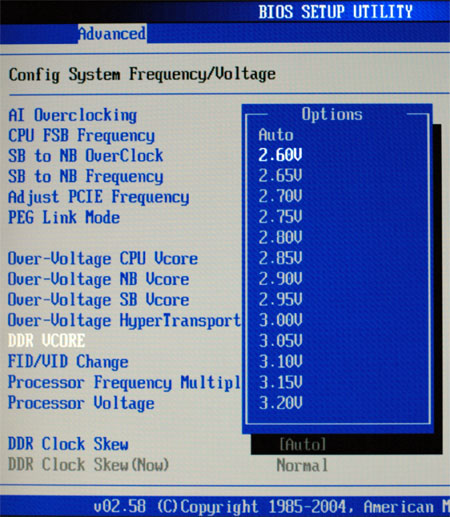
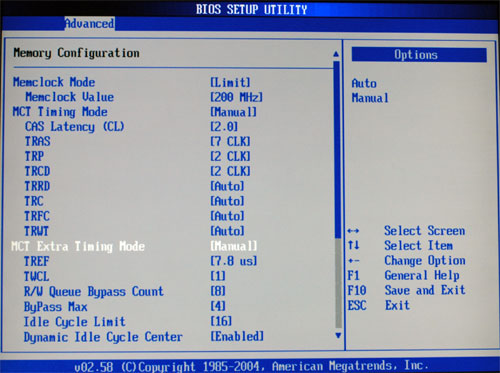
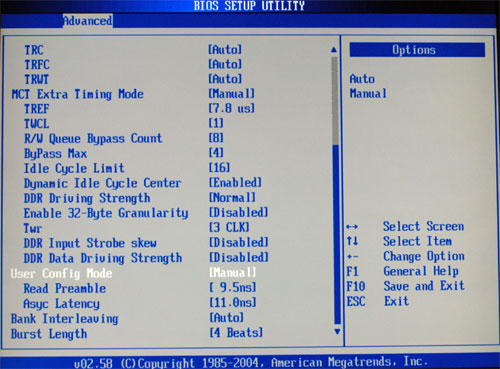
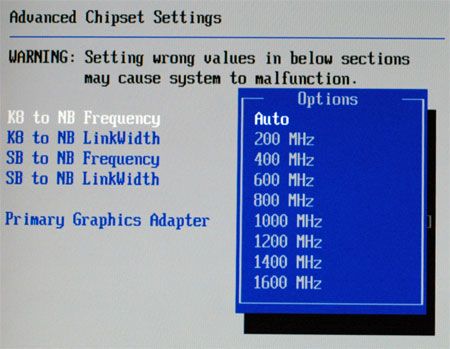
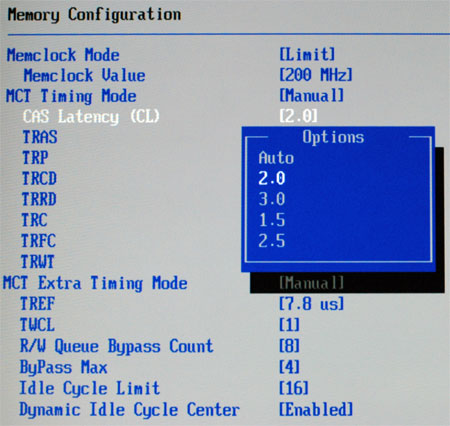










95 Comments
View All Comments
Per Hansson - Sunday, November 6, 2005 - link
Hi, what type of capacitors did Asus choose to use on this mainboard?It looks like all caps are of the same type, (bar the CPU filter caps) is it Chemicon perhaps?
Klaasman - Sunday, November 6, 2005 - link
You guys at Anandtech should try cleaning the dust out of your HSF once in a while.Wesley Fink - Sunday, November 6, 2005 - link
We have received a number of emails questioning our results since some other sites who found twice the performance with Dual x16 tested with the nVidia SLI-AA option enabled with Coolbits in very recent nVidia drivers.We have complete results of SLI-AA testing with Far Cry - Regulator, the same game tested by sites claiming the 50% performance gain for Dual x16, but we no increase at all in SLI-AA performance.
ALL components except the motherboard are the same. We even moved the hard drive between the systems to make SURE everything but the motherboard remained the same. Results were the Average of two runs with the very latest 81.87 videodrivers. Memory was 2x512MB of our standard OCZ PC3200 Platinum Rev. 2 at 2-2-2-7. Memory and CPU were exactly the same in both systems, and the same MSI 7800GTX cards were used for benchmarking.
nVidia SLI-AA Mode - Far Cry - Regulator Demo - 1600x1200
8X SLI-AA 16X SLI-AA
Asus A8N32-SLI Deluxe 37.22 20.59
DFI LANParty nF4 37.89 22.19
As you clearly see, there is NO difference with nVidia SLI-AA between Dual x8 and Dual x16. In fact the Dual x8 scores are slightly faster, but they are well within error margin and I would call them equivalent - the same.
Live - Sunday, November 6, 2005 - link
Nice to see this one cleard up. To bad you where right and they where wrong, performance wise that is.mctmcpoop - Saturday, November 5, 2005 - link
Cound you re-test and compare the result from different X16 bus in A8N32 ? If the X16 slot result from the NF4 chipset is lower compare to X16 from C51D , we can be sure that the C51D X16 is much faster than NF4 chipsetWesley Fink - Saturday, November 5, 2005 - link
This is a really good idea. The only problem is the Micro ATX boards that have this North Bridge do not normally have the memory timing options and other tweaks to allow a direct comparison. Also with an enabled integrated video on the C51 north bridge we are introducing a new variable. We will probably have to wait for other Dual x16 boards to see if we can duplicate these results on the newest, most demanding games.mctmcpoop - Saturday, November 5, 2005 - link
What I mean is test both of the X16 slot on A8N32 , one X16 bus should be from C51D pci express tunnel chip , the other X16 slot bus should be from the NF4 chip as other normal SLI board ... So if the right X16 slot get good score compare to left X16 slot , that means C51D chip has better design of the pci express x16 bus ...Wesley Fink - Sunday, November 6, 2005 - link
I ran some quick tests comparing the North x16 slot (nearest to CPU) and the South x16 slot on the Asus in the 3 new games that showed the big single-video increases. The South x16 slot was consistently slower than the one nearest the CPU by 2% to 6.7% in our single video performance tests. Perhaps there are difference in performance of the MCP51 and nF4 SLI which each drive one of these slots. We will look at these results again in future Dual x16 board reviews.lopri - Saturday, November 5, 2005 - link
Another question for Wesley:When you say OC isn't as good with SLI as with a single video card setup, is it in general? Or this particular board? Also, what's the reason for it? CPU? Chipset? Power regulation on the board?
Thanks again for a great review! I'm eagerly waiting for this board!
Wesley Fink - Saturday, November 5, 2005 - link
We have noticed that SLI will not overclock as high on other nForce4 boards as well, but I can't tell you the max on each one for SLI. I made this comment because I couldn't duplicate an overclock I had run earlier on this board, realized I had SLI set-up, removed the 2nd card and ran a few quick tests to see the impact of SLI on maximum overclock.